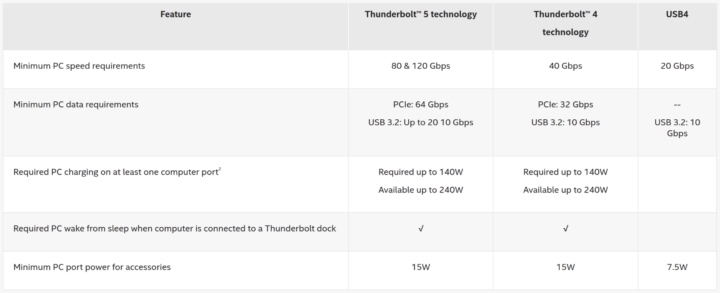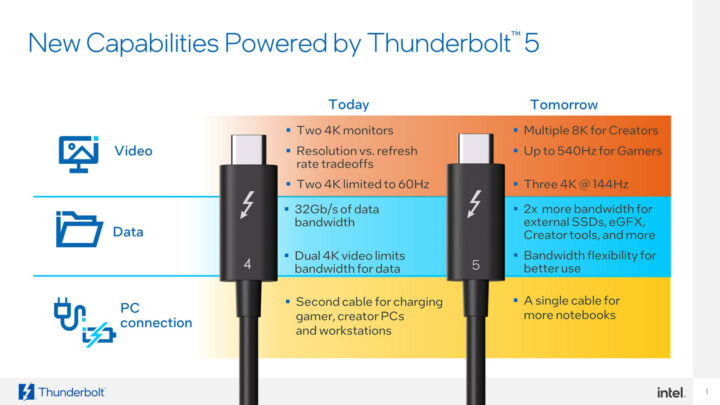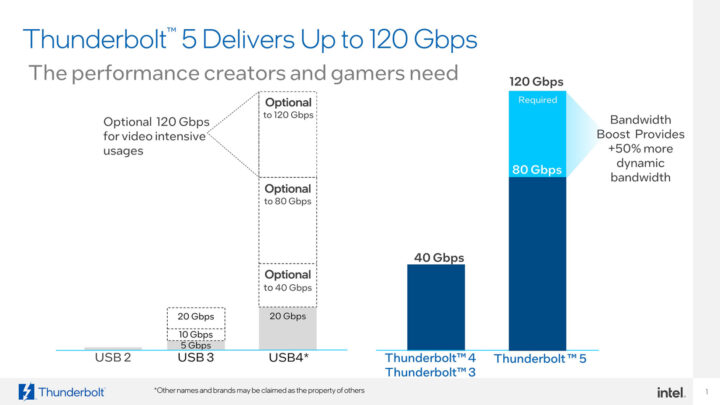Intel has just announced Thunderbolt 5 and demonstrated it with a prototype laptop and dock (see the video embedded at the end of this post) with up to 120 Gbps bandwidth when using “Bandwidth Boost”.
Thunderbolt 5 will deliver 80 gigabits per second (Gbps) of bi-directional bandwidth and the top 120 Gbps bandwidth is achieved through “Bandwidth Boost” to support multiple 8K monitors, which means three times the bandwidth of Thunderbolt 4 topping at 40 Gbps.
Thunderbolt 5 builds upon Thunderbolt 4 with several improvements and features:
- Two times the total bi-directional bandwidth, and up to three times (120 Gbps) for video-intensive usage
- Double the PCI Express data throughput for faster storage and external graphics.
- Compatible with USB4 V2, DisplayPort 2.1, and PCI Express Gen 4
- Double the bandwidth of Thunderbolt Networking for high-speed PC-to-PC connections.
- PAM-3 signaling technology to deliver increases in performance with today’s printed circuit boards, connectors, and passive cables up to 1 meter. (So the active cable needed to reach 80 Gbps in USB4 V2 might not be needed… TBC)
Intels says the new Thunderbolt 5 standard will deliver the bandwidth needed by content creators, gamers, and professionals. While Thunderbolt 4 can now be found in many mini PCs, I’m not convinced this will be the case for Thunderbolt 5 anytime soon, until the time when high-resolution 8K displays drop in price, although the need for faster storage and high-performance eGPU may also help drive the adoption of the new standard.

Having said that, Thunderbolt 5 should be found in premium PCs and laptops soon enough, as Intel’s controller, codenamed Barlow Ridge, is expected to be available starting in 2024.
Further information may be available on Intel’s press release and the product page.

Jean-Luc started CNX Software in 2010 as a part-time endeavor, before quitting his job as a software engineering manager, and starting to write daily news, and reviews full time later in 2011.
Support CNX Software! Donate via cryptocurrencies, become a Patron on Patreon, or purchase goods on Amazon or Aliexpress







An area completely missed is powering: TB5 means 140W mandatory (100W with TB4) and up to 240W with active cables (5A @ 48V).
Did you mean 240W manditory? Wonder how laptops are going to support that. I can’t imagine many of them will be able to source that–for very long.
Nope, I’m not seeing it elsewhere: 140W manditory and 240W optional. I still think 140W is going to be a hell of a burden unless that’s only for some devices. I can’t see laptops and PC add in cards being able to do that. That’s two 6 pin PCI-E connectors or one 8 pin. That’s a lot of power to spare for a single port on a machine.
I’m a bit confused by those requirements, as I’ve covered and reviewd some mini PCs with one or two Thunderbolt 4 ports that ship with a 65W power adapter.
Standard USB PD 3.1 spec, nothing weird, still 5A, just higher Voltages.
[ theoretically (and not a problem within an cable, epr marked above 100W and for 5A, with standardized conditions), but read there are no(?) devices utilizing even 180W, and there’s a tendency for sparks >30V with disconnecting while on (full, >0.5A) power. Maybe there are only small capacities or there’s some unplug feature, but not heard about it, yet, OTOH not much complaints about disconnect difficulties either (comparable situation would be for POE_48V(?), what’s ~43-57V, but lower power transmission allowed, 802.3bt-2018 on device 40-71W(5-19W possible cable losses, dep. on length) ). AFAIR there are no different length USB-C pins compared… Read more »
No sparks, as the power is negotiated after plugging in the connector. Initially it’ll only be 5V/1A or thereabouts, then the devices negotiate the power, so pretty safe I’d say. As for sparks when disconnecting, well, I presume it has been tested and you’re mistaken as far as the pin length is concerned.
[ (if this still is a reasonable assumption without knowledge on all specification details and engineering precautions) the difficulty would be with disconnecting (connecting incrementally increases power, so should disconnecting?) Thx for the connector detail, that’s ~0.5-0.7mm(?) difference in length, ~0.25-0.5s for mean disconnect time for USB-C (6.5mm) or USB-A (14.8mm) connector with human use, might result to ~1/20-1/50s (20-50ms) between shortest (e.g. Configuration channel) and longest pin (Ground, Bus power) getting electrically disconnected(?). That probably is too short for software enabled adjustments (within all circumstances), but sufficient for circuits limiting disconnect currents(?) Never thought about that before. Btw, there’s… Read more »
[ just found, length of an established arc ~48V with bridging an air gap (1kv/mm) is maybe ~1mm, so normally no problem, i assume ]
Thanks for the addition. I’ve added a table from the Intel website with some of the requirements, I’ve been on holidays for the last week, and will be for several more weeks, so I don’t spend as much time on each articles.
> the top 120 Gbps bandwidth is achieved through “Bandwidth Boost”
This is an asymmetric mode. Usually there’s 80/80 Gbps bidirectional but when the host detects a bunch of high resolution displays it switches to 120/40.
Thanks for stating that, that’s how I had been assuming it was doing it, but I’ve never seen any tech coverage that outright stated it. I wonder how dynamically it can do it? At least every plug event, I assume–from the dock’s standpoint I mean. Just having three monitor ports shouldn’t force the mode until actual 4K monitors get plugged in and turned of so that the BW is needed.
Can you imagine needing to turn your monitor off to get faster disc access? 🙂 It’s like the C64 turboloaders all over again.
It’s mainly for driving high resolution/refresh rate displays, not so much for PCIe data.
And the same that USB4 will deliver soon enough.
Intel really needs to stop spreading FUD about USB4, the two are now pretty much the same, minus the networking over TB and some Intel specific features. On top of that, Intel is a USB-IF board member and is only doing this to sell more TB chips.
Thunderbolt 5 still doesn’t support USB 3.2 Gen 2×2, which is just lame.
I don’t understand why it’s not pointed out more often that Thunderbolt N is just a copy of the latest USB standard.
Whatever is specific to Thunderbolt should be rolled into USB. USB has its own problems with naming and optional features but that can be fixed if the industry cares.
Actually, it’s not a copy, Intel “donated” Thunderbolt 3 to the USB-IF and USB4 is based on that. However, the elegantly named USB4 Gen 4 standard supports 80 Gbps symmetrical speeds, as well as 120 Gbps asymmetrical speeds and did so before Thunderbolt 5. I have a lot of insider information with regards to some of the things that have gone on inside the USB-IF with regards to USB4, but unfortunately, I can’t share them, as it would put some people in the industry in trouble and I wouldn’t want that, as they’re good friends. Let’s just say that not… Read more »
Still waiting for more USB 4 chips and products like postable disks and eGPU
I don’t think the eGPU’s need higher throughput than 20gbps, and regarding higher power; eGPU’s need to be able to provide over 500W to the GPU, so external power(brick) is required annually.
Postable nvme over usb4/tb5, not sure 40gb will be saturated (right now) by the fastest drives
from my experience, as using thunderbolt 3 on both hosts and egpu [razer chroma], the usable pci bandwidth is something like pcie 3.0 x2.7 (tbt3 have mandatory display bandwidth sharing; tbt4 can use almost pcie 3.0 x4 bandwidth, without encoding overhead, etc). so, having an rtx3090, i could find that performance is lower than half when i’m using with egpu, compared with usage with a motherboard, pcie 3.0 x16. so 20gbps (pcie 3.0 x2) is… ok for gt1030, i think :))) also, no difference for rtx3090 when is used on a motherboard, either with a pcie 4.0 x16 or pcie… Read more »